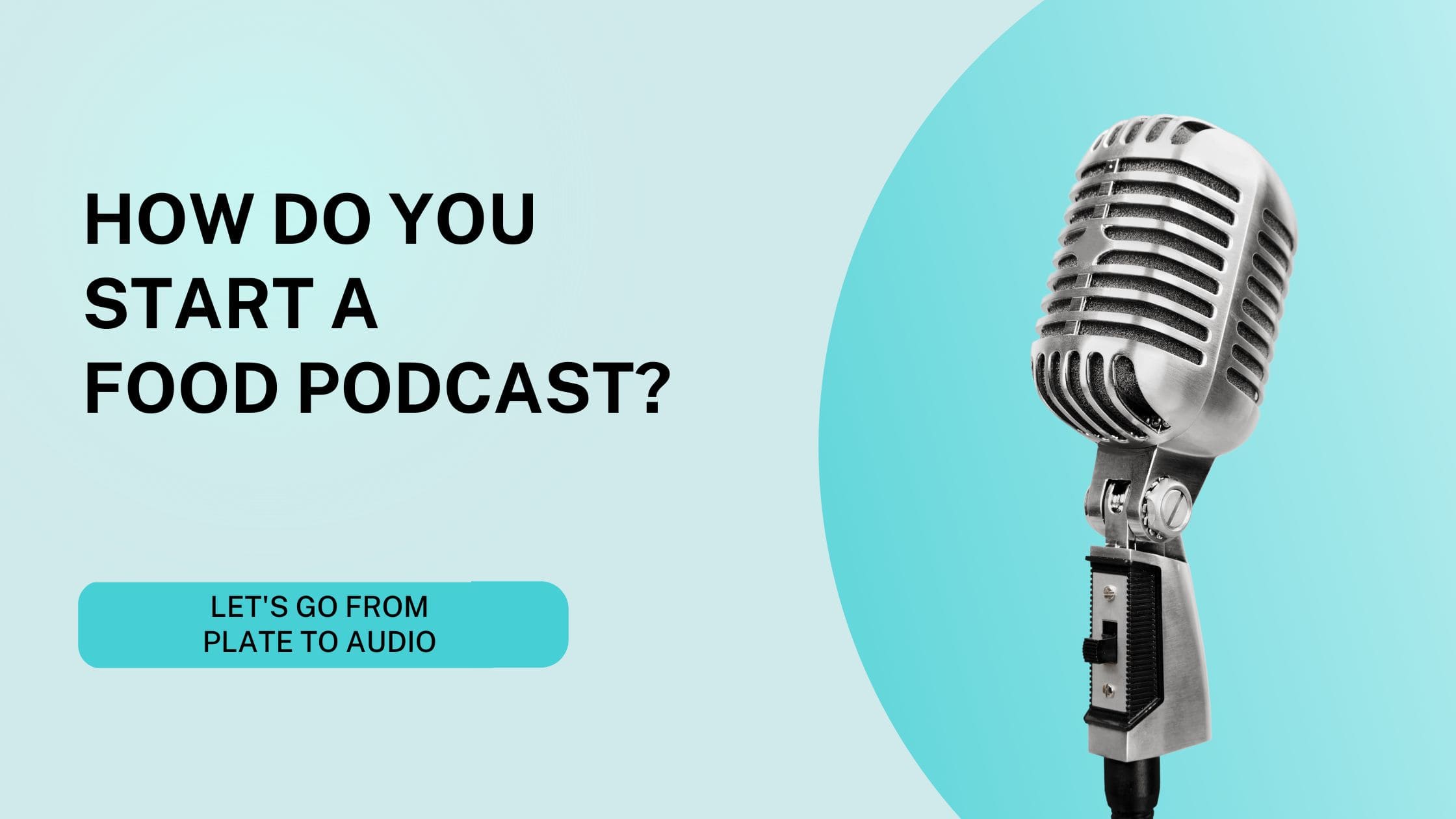In this post, I’m sharing the answer to the question “How do you start a food podcast?” Let’s go from plate to audio! This post does contain affiliate links. If you purchase any product/service through one of my affiliate links this website will receive a small commission at no additional cost to you. Thank you for your support!
Why Start a Food Podcast at All?
Starting a food podcast involves several key steps. But you might be wondering – why would anyone want to start a food podcast in the first place? Starting a podcast to promote a food-based business, such as a food blog, restaurant, or YouTube channel, can offer several benefits. Here are some key advantages:
Enhanced Visibility and Reach
Podcasts have gained significant popularity in recent years and provide an opportunity to reach a broader audience. By creating a podcast, you can tap into the growing podcasting community and expand your brand’s visibility.
Authentic Connection with the Audience
Podcasting allows you to connect with your audience in a more personal and authentic way. Through your voice, storytelling, and conversations, you can establish a deeper connection, build trust, and engage with your listeners on a more personal level.
Expert Positioning and Thought Leadership
Hosting a podcast gives you a platform to share your knowledge, expertise, and insights about the food industry. By consistently providing valuable and relevant content, you can position yourself as an authority in your niche, establish credibility, and develop a loyal following.
Content Repurposing
Podcast episodes can serve as a foundation for creating other types of content. You can transcribe the episodes into blog posts, create video snippets, or share highlights on social media. This repurposing helps maximize your content’s reach and offers diverse formats to cater to different audience preferences.
Collaboration Opportunities
Podcasting opens doors to collaboration with other professionals, influencers, or experts in the food industry. By featuring guest interviews or participating in joint episodes, you can tap into their audiences and expand your network, resulting in cross-promotion and increased exposure for your business.
Long-Form Storytelling
Unlike shorter-form content like blog posts or social media updates, podcasts allow for long-form storytelling. This format enables you to dive deeper into topics, share personal anecdotes, and engage your audience through immersive narratives, creating a more memorable and impactful experience.
Audience Feedback and Interaction
Podcasting is a two-way communication channel. Listeners can leave comments, send emails, or engage with you through social media, providing valuable feedback and insights. This interaction helps you understand your audience’s needs, preferences, and challenges, allowing you to tailor your content and offerings accordingly.
Monetization Opportunities
As your podcast grows in popularity, you can explore various monetization options. These can include sponsorships, partnerships, affiliate marketing, merchandise sales, or even leveraging your podcast’s success to attract potential investors or collaborators for your food-based business.
Versatility and Convenience
Podcasts are a versatile form of content that can be consumed anytime, anywhere. Your audience can listen while commuting, cooking, or exercising. This convenience increases the likelihood of regular engagement, as it fits into their daily routines and offers an alternative to visual-based content formats.
Brand Building and Business Growth
A well-executed podcast can contribute to your overall brand building efforts and lead to business growth. By consistently delivering valuable content, building a loyal audience, and promoting your food-based business, you can increase brand recognition, attract new customers, and generate additional revenue streams.
Remember, starting a podcast requires careful planning, consistent effort, and dedication. It’s important to develop a clear content strategy, invest in quality equipment and production, and prioritize engaging storytelling to make your podcast stand out in the competitive podcasting landscape.
I’m in! How Do I Start My Food Podcast?
Alright, now that you know the benefits of starting a food podcast, let’s get your ideas into the ears of your dream listeners, shall we? Here’s a general guide to help you get started:
Define Your Podcast Concept
Determine the specific focus and format of your food podcast. Consider your target audience, niche, and the unique value you can provide. This will help you create a clear vision for your podcast.
Plan Your Episodes
Outline the topics, themes, and structure for your podcast episodes. Create a content calendar to ensure consistency and organization in your podcasting schedule.
Obtain Equipment and Software: Invest in essential podcasting equipment, such as a quality microphone, headphones, and a pop filter. Additionally, choose podcast recording and editing software that suits your needs. Popular options include Audacity, GarageBand, or Adobe Audition.
Create Introductory Music and Artwork
Develop an intro jingle or music that represents your podcast’s vibe. Design artwork or a logo that visually represents your podcast and captures the attention of potential listeners.
Record and Edit Episodes
Set up a quiet recording space and start recording your podcast episodes. Aim for good audio quality, clear speech, and engaging content. After recording, edit your episodes to remove any mistakes, add music or sound effects, and create a polished final product.
Choose a Podcast Hosting Platform
Select a podcast hosting platform that will store your podcast files and distribute them to podcast directories such as Apple Podcasts, Spotify, or Google Podcasts. Popular hosting platforms include Libsyn, Podbean, and Buzzsprout.
Submit to Podcast Directories
Submit your podcast to major podcast directories to make it accessible to a wider audience. Each directory will have its submission process, so follow their guidelines to get your podcast listed.
Create a Website and Promote Your Podcast
Build a website for your podcast where listeners can find information, episode show notes, and subscribe to your podcast. Promote your podcast on social media, food-related forums, and other platforms to attract listeners.
Engage with Your Audience
Encourage listener feedback, questions, and suggestions. Engage with your audience through social media, email, or a dedicated podcast community to build a loyal following.
Continually Improve and Evolve
Regularly review and assess your podcast’s performance. Analyze listener feedback and adapt your content and format to meet their needs. Seek opportunities for growth and improvement in your podcasting journey.
Remember, starting a podcast requires time, effort, and consistency. Be patient, stay passionate about your topic, and enjoy the process of sharing your love for food with your audience.
How Do You Repurpose a Food Podcast Into Other Content?
Repurposing your food podcast into other content can help you reach a broader audience and extend the lifespan of your podcast episodes. Here are some ways to repurpose your food podcast:
Transcribe Episodes
Transcribe your podcast episodes into written form. You can publish these transcriptions as blog posts on your website. This not only provides an alternative format for consuming your content but also improves search engine optimization (SEO) and accessibility.
Create Blog Posts
Expand on the topics discussed in your podcast episodes and create dedicated blog posts. You can offer additional insights, tips, and resources related to the episode’s subject matter. Embed the podcast episode within the blog post to encourage readers to listen as well.
Produce Video Clips
Take interesting or informative segments from your podcast episodes and create short video clips. Add visuals, text overlays, and engaging graphics to make them visually appealing. Share these video clips on social media platforms like YouTube, Instagram, or Facebook to attract a wider audience.
Develop Infographics
Condense key information from your podcast episodes into visually appealing infographics. Use graphics, charts, and concise text to present the information in an easily digestible format. Infographics are highly shareable on social media and can drive traffic back to your podcast.
Compile “Best of” Episodes
Select the most valuable or popular episodes from your podcast and compile them into a “Best of” series. This can be a separate podcast feed or a special collection available on your website. It allows new listeners to discover your podcast through curated content.
Guest Posts and Collaborations
Reach out to other food bloggers, influencers, or websites in your niche and offer to write guest posts or collaborate on content. You can repurpose your podcast episode topics into written articles or provide unique insights for their platforms, linking back to your podcast for further engagement.
Create eBooks or Guides
Consolidate your podcast episodes on a particular theme or topic into an e-book or downloadable guide. Add additional content, tips, and recipes to enhance the value. Offer it as a free resource or for purchase to monetize your repurposed content.
Host Live Q&A Sessions
Organize live Q&A sessions on social media platforms or through webinars. Encourage your audience to ask questions related to your podcast episodes or food-related topics. This provides an interactive way to engage with your listeners and create additional content in real-time.
Remember to repurpose your content strategically, tailoring it to suit the platform or format you’re utilizing. Each repurposed piece should entice and engage a different segment of your target audience, leading them back to your podcast for more in-depth content and connection.
Ready to Launch Your Food Podcast?
It’s time! Take all those sexy ideas and put em into action my friend! Start brainstorming, draft a plan, and then work the plan. And, when you’re ready, use RSS.com to launch your show. You can get started for free using code RSSFREEMONTH for a free month of podcasting at checkout. Click here to get started now!
Read More Posts in my Podcasting Series
- Expert Round Up – Tips for First Time Podcasters
- How to Promote a Podcast: Common Mistakes in Promoting
- How to Find Your Podcast Niche to Create Content
- How to Use Podcasts to Build Your Personal Brand and Network
- How to Use Podcasts to Connect with Your Target Audience
- How to Use Podcasts to Land Your Dream Job
- Podcasting For Authors – Can You Sell More Books with a Podcast? YES!
- The Importance of Branding in Podcasting
- Legal Considerations for a Podcast – Are You Podcasting Legally?
- Does Podcast Equipment Still Matter?
- 6 Fun Ideas for Promoting Your Podcast
- The Importance of Storytelling in Podcasting
- Why Starting a Podcast Is the Perfect Side Hustle
- Podcasting for Your Brand – Make Your Business Famous
- How to Measure the Success of Your Podcast
- How to Turn Your Podcast into a Live Event – Building Community Around Your Podcast
- Podcasting as an Educator – Step By Step Guide to Sharing Your Lessons on a Mobile Medium
- Podcasting for Comedians – Using Your Podcast to Book More Shows
- Podcasting for Musicians – Step By Step Guide to Using Your Podcast to Promote Your Music
- Podcasting for NonProfits – Everything You Need to Know
- Step By Step Guide to Maximizing Your Podcast Donations






